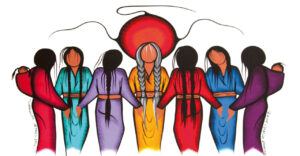Education on Digital Citizenship and Talking Circles as a way to heal
 The two documentaries I watched highlight the significant dangers of social media, particularly for young people. TELUS| Dark Cloud: The High Cost of Cyberbullying examines the devastating impact of online harassment, centering on the tragic case of Amanda Todd, a Canadian teenager who took her own life after relentless cyberbullying and exploitation. The film explores how social media can amplify harm, making it easier for bullies to target individuals without direct confrontation and harder for victims to escape. It also raises the issue of digital footprints, showing how once something is posted, it can follow a person forever.
The two documentaries I watched highlight the significant dangers of social media, particularly for young people. TELUS| Dark Cloud: The High Cost of Cyberbullying examines the devastating impact of online harassment, centering on the tragic case of Amanda Todd, a Canadian teenager who took her own life after relentless cyberbullying and exploitation. The film explores how social media can amplify harm, making it easier for bullies to target individuals without direct confrontation and harder for victims to escape. It also raises the issue of digital footprints, showing how once something is posted, it can follow a person forever.
The second documentary I chose to watch, TikTok: Eating Disorders, Racism, Censorship, and Distorted Realities, investigates the dark side of TikTok’s algorithm and how it shapes users’ experiences. It reveals how the platform’s recommendation system can create harmful echo chambers, exposing young users to content that reinforces dangerous behaviors like disordered eating. Rather than discouraging unhealthy habits, the algorithm often intensifies them by continuously feeding similar content. The documentary also touches on issues of censorship and racial biases, questioning how certain voices are silenced while harmful trends are allowed to thrive.

Living in an age of technology has become increasingly difficult as both a digital citizen and a teacher. I am fortunate to have grown up in an era where technology was evolving but did not yet control our lives. I was around to see technology emerge, and I personally know people who were bullied online, which was difficult because I remember when Amanda Todd took her own life the year after I graduated high school. From that point I remember watching YouTube videos of people doing “Index Card Confessions”, which I felt was people bringing awareness to bullying, and I unfortunately blinded myself to the continuous bullying and harassment others faced. Today, however, social media has become an almost constant presence in children’s lives and they spend more time online than engaging in face-to-face interactions, forming friendships, communicating, and striving for validation through followers and influencers. Which, is an outlet for online bullying, harassment, low self-esteem and causes them to seek for constant validation.
Common Sense Education has created a curriculum called “Everything You Need to Teach Digital Citizenship”, which outlines digital citizenship lessons from K-12. It does a great job covering all topics, even ones I hadn’t considered like Curated Lives and how they are presenting their lives online. Another great thing is it includes videos, lesson slides, and customizable resources.
A similar resource from PBS has a whole section on “Technological Literacy” which provides many of the same resources and lessons as Common Sense Education. Although, PBS provides videos that are both informational and engaging.
The concept of an “algorithm” is particularly unsettling because it curates content based on what it determines users want to see, often without their explicit control. In the TikTok documentary, it was alarming to see how the algorithm contributed to the development of eating disorders in young girls. One might expect the platform to discourage harmful behaviors, yet instead, it reinforced them by continuously feeding users content that encouraged disordered eating. This raises serious concerns about the influence of social media on impressionable minds and how platforms prioritize engagement over well-being. I have even found myself coming across videos pushing certain political views or news, rather than just videos that I consider fun or funny. But I feel as though I am aware enough that I try not to “like” or watch those videos so they do not come across my feed as often, although for young minds they may not have the same instinct. I find that TikTok also spreads a lot of misinformation because many youth do not know how to fact check or look for additional resources – which in itself can be scary.
These documentaries left me deeply disheartened. I struggle to comprehend how people, especially children, can engage in such extreme harassment online. However, I recognize that the anonymity and distance provided by digital spaces make it easier to act without immediate consequences. As educators, we must take proactive steps to address these issues, starting with teaching digital citizenship. Children need to understand the lasting impact of their online actions and the digital footprint they leave behind.
However, education on digital citizenship alone is not always enough. External influences such as peers and family dynamics play a significant role, making it crucial to create opportunities for meaningful discussions. One approach I strongly believe in is incorporating talking circles in schools and with families. This practice, which is traditionally an Indigenous practice, provides a space for open dialogue, allowing individuals to share their experiences and feelings in a respectful manner. Beyond talking circles, another valuable practice is the use of “sentencing circles,” where a perpetrator sits in a discussion with their own family, the victim, and the victim’s family. In this setting, they confront the real consequences of their actions, hearing firsthand how their behavior has affected others. Unlike traditional punitive measures, this approach fosters accountability, healing, and the potential for real change. Imagine the difference between facing a judge or a room of strangers versus looking into the eyes of those you have harmed, alongside your own family. Which scenario would make a person reflect more deeply on their actions? We could use Talking Circles to address bullying and harassment in the same way sentencing circles are used. Bullying often persists because perpetrators do not witness the true extent of the harm they cause, and their families are not always involved in the resolution process. If we want to address cyberbullying and social media harms effectively, we must engage all parties—students, families, and educators—to build empathy, accountability, and ultimately, a safer digital world for everyone.

4 thoughts on “Education on Digital Citizenship and Talking Circles as a way to heal”
I really liked your discussion of talking and sentencing circles as a possible tool to combat cyberbullying. One of our big struggles is developing empathy and resilience amongst our students. They need to know that they are not alone, and the community stands with them. One issue I see is the ability to build trust to the point where a talking circle would be effective. Many times student cyberbullying involves public humiliation, and I wonder how willing victims would be to speak to the perpetrator. I also think that if the bully shows a lack of remorse or empathy that could also be damaging to the victim.
Yes I definitely can see the concern, although I have used this strategy and have seen it used on many occasions where it was successful. In my opinion, although the first initial intent may seem to be public humiliation a lot of it just comes from a lack of understanding, and by including not only the victim and perpetrator but the families as well helps them have a deeper understanding. The victim does not necessarily need to share – the family or someone on their behalf can share, I think by sharing the effects regardless if they lack empathy can be healing. Especially if they see the support they have behind them with family and community. The perpetrator as well will have to respond to their own families which can be more successful to reaching them than having to respond to a teacher or the victim.
Thanks for Sharing Sam, I have been a part of some of these strategies such as sentencing circles and just talking circles and there is something to say for these. But as with anything it all comes down to who is involved with it and how seriously these people take them. There are a few variables that can sabotage these options. If anyone who is in that loop needs to be accountable for their actions, and if any one person isn’t in it for the right reasons the whole thing is a little shot.
I wonder if these circles would have worked with these men who were stalking these girls? Would they show remorse? Would they be changed by the profound experience of coming to terms with what they did?
Its all very interesting and so much stays unanswered. But thank you so much for sharing your thoughts on talking and sentencing circles! Its a strategy I overlooked when thinking on these videos!
Hello
Thank you for sharing insightful reflection.